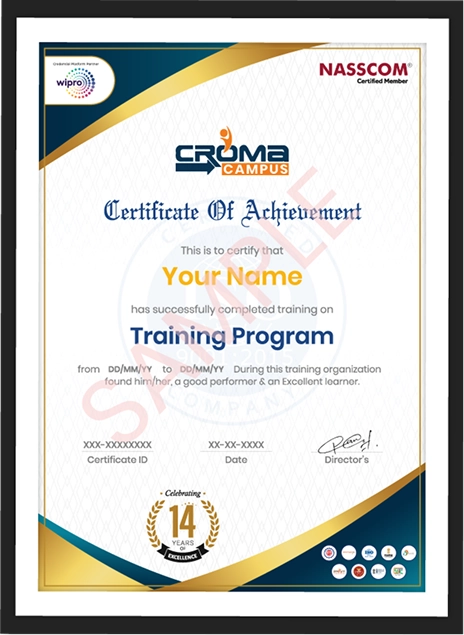Course Design By
Nasscom & Wipro
Comprehensive Understanding of Data Science: Provide a solid foundation in data science principles, including machine learning, statistical analysis, and data visualization.
Practical Programming Skills: Develop proficiency in programming languages commonly used in data science, such as Python and R.
Real-World Problem Solving: Enable participants to apply theoretical concepts to solve real-world problems using data-driven approaches.
Hands-On Experience: Offer extensive hands-on training through projects and case studies to build practical experience.
Industry-Relevant Curriculum: Ensure the curriculum is aligned with current industry standards and practices to make participants job-ready.
Analytical Thinking and Decision Making: Foster analytical thinking and data-driven decision-making skills.
Preparation for Advanced Certifications: Prepare participants to pursue advanced data science certifications and further their professional qualifications.
Career Advancement: Enhance career prospects by providing the skills needed to secure roles such as data analyst, data engineer, and data scientist.
Data Analyst: Starting salaries range from INR 3 to 5 lakhs per annum, with experienced analysts earning between INR 6 to 8 lakhs per annum.
Data Scientist: Entry-level data scientists can expect to earn INR 6 to 8 lakhs per annum, while those with more experience can command salaries of INR 10 to 15 lakhs per annum.
Data Engineer: Initial compensation typically falls between INR 4 to 6 lakhs per annum, with experienced professionals earning INR 8 to 12 lakhs per annum.
Machine Learning Engineer: Starting salaries are in the range of INR 5 to 7 lakhs per annum, with seasoned engineers earning between INR 10 to 18 lakhs per annum.
Business Intelligence Analyst: Entry-level analysts can expect to earn INR 3 to 5 lakhs per annum, with experienced professionals earning between INR 6 to 10 lakhs per annum.
Job Opportunities: Eligible for roles like data analyst, data scientist, and machine learning engineer.
High Salaries: Competitive pay for both entry-level and experienced positions.
Skill Development: Gain expertise in data analysis, machine learning, and data visualization.
Industry Flexibility: Opportunities across IT, finance, healthcare, retail, and more.
Certification Readiness: Prepared for advanced data science certifications.
Leadership Potential: Pathway to senior roles like data science manager or chief data officer.
Data Collection and Cleaning: Gather and preprocess large datasets.
Data Analysis: Identify trends and patterns using statistical methods.
Model Development: Create predictive models and machine learning algorithms.
Data Visualization: Develop dashboards and reports to present findings.
Collaboration: Work with stakeholders to understand and meet data needs.
Model Optimization: Monitor and refine models for better performance.
Documentation: Maintain detailed records of methodologies and results.
Industry Trends: Stay updated with the latest data science techniques.
Data Security: Ensure data privacy and compliance.
Mentoring: Guide and train junior data scientists.
Information Technology (IT) - Growing demand for data-driven solutions.
E-commerce - Optimizing supply chains and personalizing customer experiences.
Healthcare - Enhancing diagnostic accuracy and healthcare delivery.
Finance and Banking - Detecting fraud and developing predictive financial models.
Education - Personalizing learning experiences and improving educational outcomes.
Telecommunications - Analysing customer data and optimizing network performance.
Manufacturing - Predictive maintenance and supply chain optimization.
Retail - Understanding consumer behavior and managing inventory.
Travel and Tourism - Enhancing customer experiences and optimizing pricing.
Real Estate - Analysing market trends and predicting property values.
Machine Learning
Statistical Analysis
Data Visualization
Programming in Python/R
we train you to get hired.

By registering here, I agree to Croma Campus Terms & Conditions and Privacy Policy
+ More Lessons
Course Design By

Nasscom & Wipro
Course Offered By

Croma Campus

Stories
success
inspiration


career upgrad


career upgrad


career upgrad


career upgrad
12-Jul-2025*
14-Jul-2025*
16-Jul-2025*
12-Jul-2025*
14-Jul-2025*
16-Jul-2025*

You will get certificate after
completion of program

You will get certificate after
completion of program

You will get certificate after
completion of program
in Collaboration with






Empowering Learning Through Real Experiences and Innovation

we train you to get hired.

Phone (For Voice Call):
+91-971 152 6942WhatsApp (For Call & Chat):
+91-971 152 6942Get a peek through the entire curriculum designed that ensures Placement Guidance
Course Design By


Course Offered By

Ready to streamline Your Process? Submit Your batch request today!
The duration varies, typically ranging from 3 to 6 months depending on the program.
The course covers topics like machine learning, statistical analysis, data visualization, and programming in Python/R.
The best institute is often considered based on faculty expertise, course content, and alumni success.
Basic knowledge of programming and statistics is recommended but not mandatory for beginners.

FOR QUERIES, FEEDBACK OR ASSISTANCE
Best of support with us
For Voice Call
+91-971 152 6942For Whatsapp Call & Chat
+91-9711526942